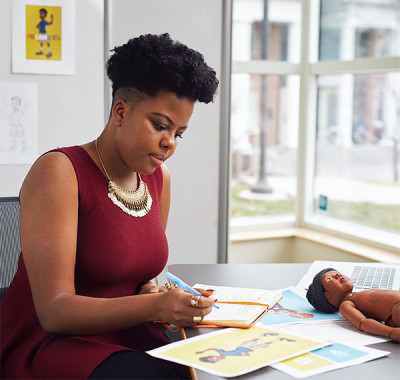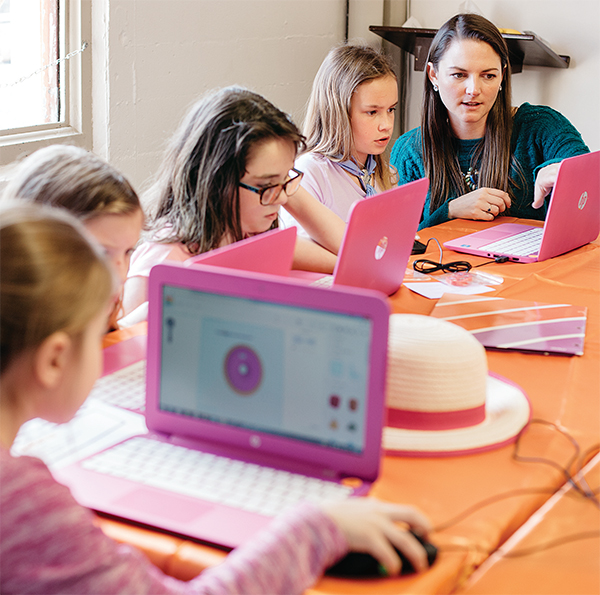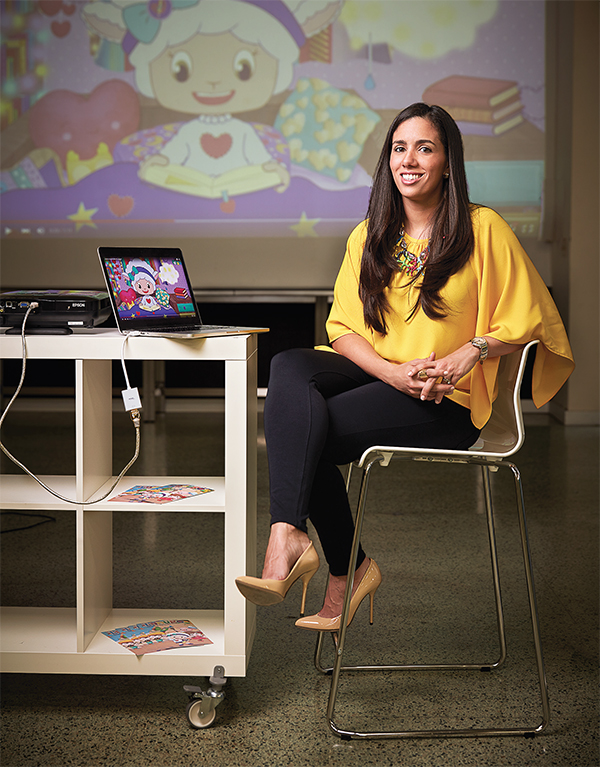
Jennifer Pierre, MSEL’16, founder of Melanites, a line of dolls for boys of color
“You don’t see yourself on the shelf.”
Jennifer Pierre, MSEL’16, is starting a toy business, so she spends a lot of time noticing what is on store shelves—and what isn’t. When she goes to Target or Toys R Us, Pierre looks at how the toys are regimented strictly by gender. Walking past the pink and glitter of the girls toys, she’ll wander down the boys aisle, where buff action figures with big muscles and washboard abs carry all sorts of weapons: swords, lasers, guns.
And, as a person of color, she can’t help but notice how the toys, for the most part, don’t reflect the diversity of the real world. “We have to change that,” she says. “We are a multicultural society.”
This sense that one’s culture, or race, or gender is misrepresented, misunderstood, or just pushed to the side drives a number of Babson alumni to action. In Pierre’s case, she founded Melanites, which is launching a line of boy dolls that serves as a “celebration of brown boyhood.” Reflecting four backgrounds (African-American, Caribbean, Indian, and biracial), the dolls aren’t brawny action figures. Instead of weapons, they come with accessory kits that transform the dolls into four identities: thinkers, doers, makers, and performers. “I’d like for the toys to break the mold in the toy industry—to be dolls in the boys aisle, and also to be diverse on purpose from the get-go,” Pierre says.
Pierre was inspired to create the dolls after volunteering at a Miami community center last summer. She had wanted to start a business for a while, but her original idea had been to create a venture focused on black girls, encouraging them to embrace and celebrate their natural hair and beauty. She changed her mind, however, as she watched the boys, second- and third-graders, all minorities, interact with each other. They mostly talked about sports, and they were always trying to prove how tough they were. “It was all about physicality,” she says. “It really opened my eyes.” She remembers one boy in particular who seemed so engaged and inquisitive with her in reading class, but then he was pressured to act in a more manly way with the other boys. “His persona was so different,” she says. “I didn’t like that.”
The boys made her think of her younger brother, Alex. He liked sports as a youngster, but he also liked to write and create stories about the adventures of his classmates. He grew up in an environment where he felt free to be both athletic and artistic. Unlike the boys at the center, he didn’t need to act masculine all the time. Ask the center boys what they want to do with their lives, Pierre says, and they talk of joining the NFL or being a rapper. “They don’t want to be a lawyer or doctor,” she says. “Sports isn’t bad. But you should have more to choose from.”
Pierre, who emigrated from Haiti with her parents when she was 3, says that she wasn’t sure what she wanted to do with her life either when she was young. She is grateful for the mentors who guided her along the way, including a high school entrepreneurship teacher who steered her through the creation of a business. “I loved the process,” Pierre says. “That really affected my life.” The class led her first to the University of Miami, where she studied entrepreneurship, and then to Babson.

Photo: Pat Piasecki
Jennifer Pierre developed her dolls, which she calls a “celebration of brown boyhood,” while at Babson.
Understanding the power of mentoring, Pierre wants to do the same for others. While in college, she taught entrepreneurship to at-risk adolescents in a juvenile detention center. And now with Melanites she hopes to inspire minority boys with a doll that looks like them but offers another way to play beyond the aggressive, hypermasculinity to which they’re accustomed. Pierre still is working out the details of the dolls’ accessory kits, but she wants them to transform the dolls into a range of roles and occupations. The dolls aren’t superheroes or Star Wars figures holding a blaster. Instead, they can be engineers and scientists, poets and musicians. Pierre wants to demonstrate the amazing possibilities of what a life can be. “I want boys to dream big,” she says. “I’m not telling them to do a certain job. I’m saying explore.”
Part of Babson’s Women Innovating Now Lab, a community of female entrepreneurs, Pierre officially launched Melanites this spring with a Kickstarter campaign. She used a 3-D printer at Babson to create a prototype of the 18-inch doll, and she hopes to place an order with a manufacturer by the summer so the dolls can be available for sale this Christmas season.
Pierre knows that breaking into the boy aisle with a doll at major retailers will be difficult, so for now she is targeting independent specialty toy stores, which may have an emphasis on educational playthings. She also is reaching out to schools and has received a lot of positive feedback from teachers, who have expressed interest in using the dolls for lessons in diversity.
Pierre’s dolls deal with the intersection of race and gender, an undertaking she calls both exciting and scary. But she has a personal mantra that emboldens her. “Create the things you wish existed,” she says. With her dolls, she is doing just that.
“Nobody ever said, ‘You should be an engineer.’”
Looking back on her younger years, Lauren Wallace ’11 wonders about this oversight, especially considering how much she once enjoyed science projects and experiments. “Maybe that was something I would have liked to pursue,” she says.
Today, Wallace is co-founder of Savvy Society, a San Francisco-based company that is trying to give girls a new perspective on possible career paths. Wallace experienced firsthand what many pundits have pointed to: Society often doesn’t do a good enough job of encouraging girls to go into the STEM fields of science, technology, engineering, and math. As Wallace moved through her teen years, she found that her initial interest in those subjects faded. “I took a sewing class instead of a Web design class,” she says. “I didn’t feel it was for me. It was all my guy friends taking it.” Wallace believes such an experience is common. “If a girl shows up for robotics club, and she’s the only girl there, she probably won’t go back,” she says.
In a subtle way, even the fact that her dad always helped with math homework, while her mom helped with English, gave Wallace an impression of what subjects suit each gender. “It wasn’t on purpose. It was just how they divided their responsibilities,” Wallace says. “But that sent a stronger message than they meant to send.” By the time she arrived at Babson, Wallace steered clear of concentrations heavy on numbers and math. She focused instead on marketing. “I thought it was for me,” she says. “It’s portrayed as this artsy, creative thing. A lot of women choose marketing.”

Photo: Annie Tritt
Lauren Wallace (far right), co-founder of San Francisco-based Savvy Society, which introduces girls to 3-D printing
After graduation, Wallace began a rotational program at JPMorgan Chase. At first she worked in operations, but then she was rotated to finance. As a financial analyst for the company’s global commodities business, Wallace suddenly found herself immersed in the numbers that she had long avoided. “I lived in Excel,” she says. “I was totally unprepared for it. I faced a pretty steep learning curve.” After a while, however, something unforeseen happened. “I realized how creative and interesting it was,” she says. “This was never where I pictured myself. But I really enjoyed it.”
Coincidentally, a close friend of Wallace’s, Alexa Fleischman, had a similar experience. Fleischman had studied public relations and communications, but after a job opened up at her workplace, she was thrust into the role of tech product management. Like Wallace, Fleischman discovered she actually liked the job, though the two friends were astonished by the startling lack of women in their respective fields. “When I looked around, I would be the only female in the room, nine times out of 10,” Wallace says.
That gender imbalance got the friends thinking. Wallace and Fleischman had talked often of starting a business together, and now they thought about their career paths, how they both had stumbled into STEM-type jobs and liked them. How many other women had never considered STEM careers an option? “We wanted to make sure the next generation of girls doesn’t need luck to find themselves in these roles,” Wallace says.
At the tail end of 2015, the friends launched Savvy Society, which introduces girls to 3-D printing. Using the kid-friendly, 3-D modeling program Tinkercad, girls design their own shoe accessories that can then be created with the powerful printers. By focusing on shoes and fashion, Wallace and Fleischman hope to capture girls’ attention. “We wanted to start with what’s interesting and then bring in STEM,” Wallace says.
At first, Wallace was unsure about focusing on 3-D printers. “We had no background in it,” she says. “Who were we to use 3-D printing?” But the more the co-founders read about it, the more astounding they found the technology. “We realized how much of a game changer it is,” Wallace says of the high-tech printers, which can be used to produce almost any shape imaginable using data from a 3-D model. “It’s turning the manufacturing industry upside down.”
Wallace and Fleischman also realized that while they didn’t know much about 3-D printing, others didn’t either. “Everyone is kind of a beginner at it,” Wallace says. So unlike other STEM jobs, such as coding, preconceived notions about who should be doing this type of work are less likely to exist. “It’s a level playing field. A new frontier,” she says. “There are a lot of programs out there focused on getting girls into coding. That’s awesome. But it’s like they’re playing catch-up.”
In the San Francisco area, Savvy Society runs two-hour workshops that show girls how to design their shoe accessories. Girl Scout troops, school clubs, and even some birthday parties have taken part. Savvy Society also has partnered with a local school to provide an after-school enrichment program. And girls anywhere can submit designs online to the company. “They get super excited,” Wallace says. “They are creating from scratch what they want. You couldn’t even imagine how detailed they can get.”
Wallace hopes to give girls an understanding of a technology they may never have known existed. “Maybe they won’t go into a career that uses this technology, but they’ll know about it, and they’ll have the confidence if they do go into it,” she says. “If they see someone 3-D printing, they can think, ‘I can do that. I’ve been designing my own shoe accessories since I was 7.’”
“There’s nothing created for us.”
As a new mom originally from the Dominican Republic but now living in the U.S., Carla Curiel ’05 wanted to pass along the best of both of those worlds to her children. She wanted them to be Americans and experience all that her new home has to offer, but, at the same time, she wanted them to learn the language and traditions that she had grown up with.
After her twin daughters were born in 2011, Curiel looked for books, clothes, and TV shows that would reflect their heritage. She found classic books translated into Spanish, but nothing new. “Goodnight Moon is an awesome book,” she says. “But if you translate it into Spanish, it’s awful. I would rather read it in English.” She found baby clothes with only simplistic Spanish messages such as “I love mom.” The cartoon Dora the Explorer was on television, but not much else. “Dora is not enough,” Curiel says. “The show is great. But it’s more to teach Anglo kids some Spanish words.”

Photo: Jeffery Salter
Carla Curiel, co-founder of Mundo Lanugo, an entertainment brand in Miami that promotes Latino culture
Faced with such inadequate options, she and her husband, Roberto Castro, co-founded Mundo Lanugo, a Miami-based entertainment company. Through its stories and characters, which appear on clothes and in videos, live events, and an app, Mundo Lanugo seeks to inspire Latino preschool children to embrace their heritage and language.
Starting out, Curiel knew one of the company’s challenges would be to create content that could grab a child’s attention. “How do we get them to be authentically interested in culture?” asks Curiel, who is Mundo Lanugo’s CEO. Her nieces and nephews living in the U.S. initially didn’t want to speak Spanish, she says, because they were too immersed in American culture. “It’s not considered fun,” Curiel says. “Kids go to school. They play games. They learn songs. It’s all in English. It’s just their reality. They’re watching TV. It’s in English. They go to Disney. It’s in English. Everything cool is in English.” Curiel knows Latina mothers who have resorted to using flashcards to drill Spanish words into their child’s memory, an approach that’s not likely to succeed. “It’s boring,” Curiel says.
Curiel and Castro thought about what they would like to pass on to their children. They came up with the concepts for cartoon characters and hired an artist to bring them to life. Each character represents a different aspect of Latino culture. Chuy the pig, for instance, is a chef, while a pair of monkeys, Mia and Muki, love the arts and traditional Latino games, respectively. Curious Gloria, a storytelling sheep, and fun-loving Quique, a colorful bird who enjoys music, round out the five main characters.
In 2013, Mundo Lanugo launched its first products, onesies and T-shirts that featured the cartoon characters. The clothes proved popular right away, and a major retailer, Buy Buy Baby, wanted to sell them. Curiel contemplated making a major investment in overseas manufacturing, but she and her husband had envisioned Mundo Lanugo as a “Latino Disney,” with popular and engaging characters that could be licensed on a range of products. “We always were thinking big picture,” she says. “We want these characters to have a following.” Curiel already was hearing from customers who wanted more of the characters’ stories, which couldn’t be told on a T-shirt. In the end, she declined Buy Buy Baby’s offer.
Since then, Mundo Lanugo has focused on building its brand and creating content for its characters. The approach has worked. Its app has been downloaded more than 50,000 times, and its videos have been viewed more than 6 million times on its YouTube Channel. The company’s videos also are broadcast regularly on Univision’s Despierta America morning show during school vacations. The company has produced digital books and is planning toys, more apps, and more clothes in the future. A major goal is bringing an animated series to air.
With corporate partners, Mundo Lanugo also puts on events full of music, food, crafts, and appearances by its characters. For this year’s Three Kings Day, a Latino celebration during the Christmas season, the company held events in Macy’s stores across seven states. “The corporations support us,” Curiel says. “They want to connect with the Latina mom.”
When Curiel attends events, she enjoys watching those moms, who tell her they are grateful for the opportunity to expose their children to their culture. They sometimes grow wistful remembering their own childhoods. “I have seen moms become teary-eyed,” Curiel says.
Reflecting on her accomplishments, Curiel thinks not only of these moms but also of her bilingual children. “I did this for my daughters,” Curiel says. “They are proud of who they are.”
